Some people become scientists because they have an insatiable sense of curiosity. For others, the interest is born of tragedy—they lose a loved one to disease and are driven to find a cure. In the case of Gertrude Elion, both are true. Gertrude was a brilliant and curious student who could have done anything given her aptitude. But when she lost her grandfather to cancer, her path became clear.
As a biochemist and pharmacologist for what is now GlaxoSmithKline, Gertrude and Dr. George Hitchings created many different types of drugs by synthesizing natural nucleic compounds in order to bait pathogens and kill them. Their unorthodox, designer drug method led them to create the first successful anti-cancer drugs and won them a Nobel Prize in 1988.
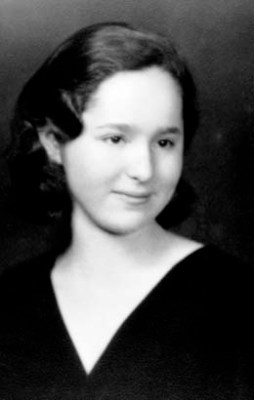
Inspiration and Perspiration
Gertrude Belle Elion was born on January 23, 1918 in New York City to hard-working immigrant parents. Her father was a dentist and he ran his practice out of a large apartment that doubled as the family’s living quarters. He did well and invested much of his earnings in the stock market, but lost it all in the crash of 1929.
In spite of this, Gertrude and her younger brother had a happy childhood. She had an insatiable desire to learn and found every subject equally interesting. When she graduated high school at age fifteen after skipping two grades, she couldn’t decide what to specialize in. Unfortunately, the answer came as she watched her beloved grandfather succumb to stomach cancer over the course of several agonizing months. From then on, she was determined to develop a cure for cancer.
Gertrude graduated in 1937 with a chemistry degree from Hunter College, a tuition-free women’s university. If not for Hunter, she may have never had the chance at higher education. There was no money for her to go to graduate school, so she applied for fellowships. But none in the field took her seriously in spite of her spotless GPA. All fifteen of the applications she sent out were rejected.
For the next few years, she worked odd jobs and volunteered at a chemistry lab just to get her foot in the door. After a couple of months, the chemist she was assisting started paying her. Soon, she was able to save enough tuition to apply to the master’s program at NYU, and put herself through graduate school with teaching jobs. At NYU she met the love of her life, Leonard Canter, and the two became engaged. Leonard spent a semester studying abroad and developed a bacterial infection in his heart valves. He died shortly after returning home. Gertrude was left heartbroken and all the more driven to fight disease. She never did marry.
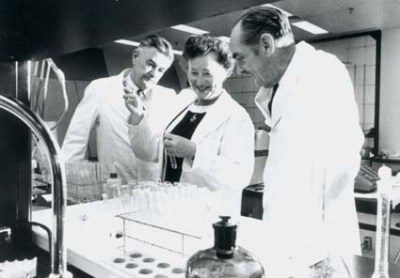
From Food Scientist to DNA Hacker
By the time Gertrude finished her master’s degree in 1941, World War II was in motion. The resulting labor shortage in industrial laboratories gave her the opportunity to prove her scientific abilities. She got a job as a food chemist doing mundane things like checking the acidity of pickles and making sure the mayonnaise was the right color. It wasn’t cancer research, but it was a start.
After a while she wasn’t learning anything and became restless. She tried using an agency to find lab positions and was eventually offered a research job at Burroughs Wellcome in Tuckahoe, New York.
She was hired as an assistant to a medical doctor named George Hitchings. Hitchings had studied purines during his time at Harvard and was intent on unlocking their mysteries. Purines are a class of organic compounds that includes adenine and guanine, two of the building blocks of DNA and RNA. Gertrude studied purine compounds of all kinds to look for differences in the metabolization process between healthy cells and pathogens like cancer cells, viruses, and bacteria.
Until this point, pharmacology was largely a process of trial and error. Hitchings wanted to use purines to develop drugs that would selectively block the growth of disease microbes without interrupting healthy cell growth. He based this idea on the recent development of sulfa drugs. Sulfates had been shown to interfere with microbial metabolism, so Hitchings reasoned that other drugs could do it, too.
They soon discovered that bacteria relied on certain purines in order to metabolize and flourish. Within a few years, they had synthesized two anti-metabolites that were structurally the same as adenine and guanine. By doing this, they essentially created decoy purines that attract pathogens but don’t support their growth. Since they can’t metabolize, the diseased cells die off.
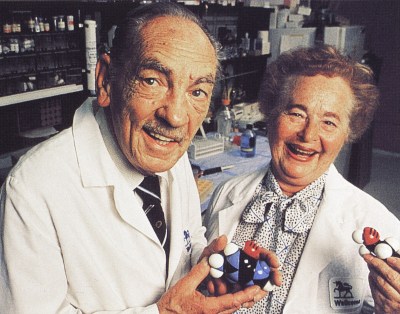
Towards a Cure for Leukemia
Soon, Gertrude created a new molecule by substituting one of the oxygen atoms of a purine with a sulfur atom. The resulting drug, 6-mercaptopurine (6-MP), held a lot of promise in the fight against childhood leukemia. It flew through the hoops of FDA acceptance and was approved a mere ten months after the clinical trials began.
Unfortunately, 6-MP wasn’t quite the wonder drug they had anticipated. Half of the children with leukemia who took it went into remission, but later relapsed and died. Gertrude spent the next six years focused on the drug and eventually found that 6-MP did in fact cure acute lymphoblastic leukemia when taken with other anti-cancer drugs.
Gertrude and Hitchings went on to create many more drugs both together and separately using the synthetic purine method. They developed drugs to combat gout, rheumatoid arthritis, herpes, malaria, and bacterial infections. One derivative of 6-MP was found to suppress the immune system. This led to the development of azathioprine, an immunosuppressant that makes the body less likely to reject donor organs after transplant surgery.
Gertrude was made head of the Department of Experimental Therapy in 1967 and kept that post until she retired in 1983. When Glaxo Wellcome moved to Research Triangle Park in 1970, Gertrude went with them and remained there until her death in 1999. After retiring, she continued to work as a consultant to her old colleagues and helped them develop AZT, the first successful drug used against HIV. She and Hitchings received the 1988 Nobel Prize for Physiology or Medicine along with Scottish pharmacologist Sir James Black.
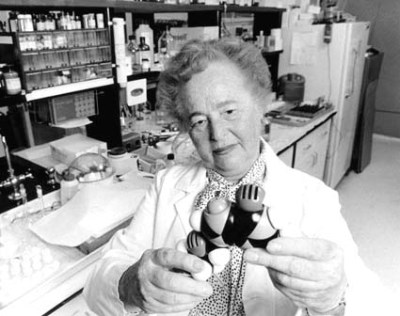
A Selfless Scientist
In spite of all the obstacles she faced, Gertrude never got discouraged. She found her work immensely rewarding and to her, winning the Nobel Prize was just icing on the cake. The real happiness was in the work itself—saving lives and healing others.
Gertrude received numerous awards including a National Medal of Science and 23 honorary degrees. She sat on dozens of boards and served several committees, tirelessly giving of herself to science and its students until the end.

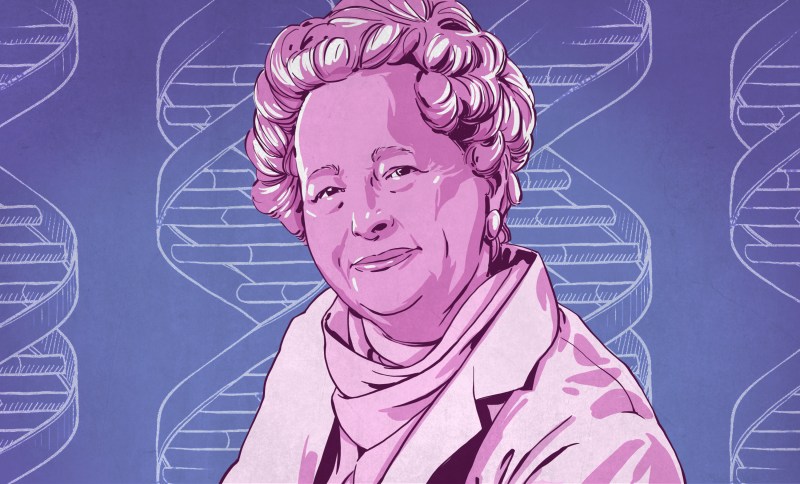














I see in a number of relatives, a family tragedy/disruption will change the course of some children to learn more about the nature of the challenge and help others overcome it.
And I also see in others facing the same or similar challenges a rejection or avoidance, and they are lesser for it.
Although I would class this articles tone as an irritating sycophantic rhetoric, the principle core of science has never been limited to institutional process. Sure there will be a line of people willing to take credit for others, but those who want to know how nature works will ultimately move society forward in-spite of itself. Institutional politics are still a problem, and that has been the case for hundreds of years.
The secret is that anyone can discover something profoundly important, but society likes to believe luck favors the meritocratic ( https://en.wikipedia.org/wiki/Illusion_of_control#By_proxy ).
So what you are saying people being able to do something in a field aren’t likely to be “lucky” in that field?
Your straw-man argument is pretty funny….
In general, people like to believe that they are unique — but solved costly problems are often unintentionally duplicated many times over — given the same text-book education, faculty resources, and arrogant culture.
We see it on hack-a-day all the time, as the first page Google result becomes a fact for the gullible.
From my experience… take time, resources, smart work and dedication unless there is serendipity involved. Researching to be the best at whatever you are studying, holding your ground, moving forward, dealing with failure and accepting the truth of the situation and moving forward again after determining gaps in the system from a FEMA and/or CAPA investigation. Striving for impact and positive change for the longest term with others coming into the situation blind, if not mislead or worse.
I’ll hold on much more writing of experience, as this field is challenging for me. I tend to digress to epiginomic issues where diagnostics are not as thorough of unknowns and even knowns as can be from the range of genomics unique to the patient down to what I’ve driven to be advocated more in need… vitaminomic, mineralomics and more detail analysis of the protienome/proteome and metabolome in general with thorough attention to detail. Emotional magnification moment. Beep!
I’ll hold on much more writing of experience, as this field is challenging for me. I tend to digress to epiginomic issues where diagnostics are not as thorough of unknowns and even knowns as can be from the range of genomics unique to the patient down to what I’ve driven to be advocated more in need… vitaminomic, mineralomics and more detail analysis of the protienome/proteome and metabolome in general with thorough attention to detail of inputs, processes and outputs. Emotional magnification moment. Beep!
Males using means so weak and false as gender bias to discount half the competition or steal accomplishments places us and all future generations at risk. It is a dis-service to humanity, and humanity is both male and female or would not exist. Competence knows no gender.
Actually you’re also missing something there. The drug is also prescribed, first off-label, and now on, for a class of diseases called IBD. Unfortunately I have one, and it was caused by over user of a certain form of an Acne buster, no not Retin-A, but after being prescribed 6-MP in that fashion it went into faster remission.
You’re right Kristine, it isn’t a wonder drug, but it comes close, and that counts only in horseshoes and phasers and photon torpedoes and blasters and proton ones..
Azathioprine is also used in the treatment of IBD (http://www.crohnscolitisfoundation.org/), in addition to preventing transplant rejection.
Thanks, Gertrude Elion!
Oh quite.
I’m also on 5ASA and it is quite a wonderful drug. It is the active agent in the stuff that’s normally first prescribed. The other stuff was sulfa, and that’s good for only so much.
Reminds me of Xylitol as a carbohydrate, like the noted in the great article ribonucleic acid, effect in regards to antibiotic and I forget if antifungal effect.
I forgot to note that my undergraduate research was investigating a novel synthetic method for an a-cyclic carbon nucleoside shadowmycin. So this article has a lot of emotional attachment to me from a broad range of issues that most do not likely observe that can be hacked into in regards to society in general to assure a general healthier, safer, welfare and well being positive impact effect. Mainly, bio-equivalent medicine potential that I think is being overlooked to create injury, maiming and murdering via poisoning and mental facilities serious bodily harm with not polymorph chemically bio-equivalent medicine that even more-so can be like the 21st Century Cures legislation vision… enable treatment unique to the patients genetics, epiginome, transcriptome, proteome, metabolome, etc. that does in fact cure the disease.
I decided to take it upon myself to investigate potential microwave synthetic methods when working on the shadowmycin novel organic/organo-metallic synthetic routes… that lead me down a tangent where I didn’t do the best in diagnostic work… though did the best I could with the resources to determine potential valid synthetic methods and the different products from the same reactants when using microwave assisted methods.
I can also disclose for the molecular hackers… that my microwave theory was based on my infrared spectrometer I built in high school before being targeted by the local acting unreasonable deviants from trafficking operations looking official… where if you think about the functional group energies like for infrared, vibrational energy, or microwave, rotational energy, or UV, electronic energy or RF energy, magnetic resonance… you can use specific tuned frequencies to aid in the reaction you want to have for the desired products from the reactants based on the functional groups resonances, i.e. electronic, magnetic, vibrational and rotational.
Therefore, tune the molecule to react most efficiently and effectively for your products desired. I think there is more computational synthetic chemistry potential on the horizon if not secretly invented already that can better determine synthetic routes based on system temp, pressure, volume and I think the equation of state can add frequency coefficients.
This paradigm of valid thinking can be used in medicine also and is convoluted by con artist acting like they perform the sciences.
Oh, yeah… to lower energy requirements so not to waste heat and better control the reactions if the point didn’t come across. Seems survival can be boiled down to life equals time and resources. Resources equal mass and energy. Seems the planet with turn into Venus if we don’t keep cool.
Hey, this pisses me off in regards to radiation treatment which may even be able to be used for other tissue agonizing or antagonizing as well as invasive tissue destruction and I’ve ranted about this before on here though not so broad application. I guess the Rife comment got me going.
You don’t need to post this, though is a great idea for coupling with say like the USAF tech (https://www.youtube.com/watch?v=r-dEXaSJWME shown at about 2:35 in) used to determine diffusion, refractive index, etc. of missile trajectory in the sky for targeting missiles then tactically destroying the invasive tissue with this type of non-ionizing radiation treatment at optimal frequencies for tissue penetration and specific tissue targeting: https://www.youtube.com/watch?v=sOrby692Uag
There are definitely more advanced ways to target and destroy diseased tissue… though I’m sure most know how morbid certain sub human people groups can be even if they don’t look that way in civil servant or civil systems.
.
Rife?
Right… in more than one way.
Really, though in regards to the gentleman I guess… I’m not sure as I haven’t verified either fundamental frequencies or harmonics and for membrane type systems (vs reed or string like for range of molecules to more complex primary to quaternary protein structures or larger systems) I’d guess there are overtones that are not multiples of the fundamental harmonic that may resonate with the different cellular structures and organisms fundamental frequencies or overtones.
I wonder about undertones also as I’ve read some patent work studying the human biology from color EMS range on down as there is something like with blue light and red light with plants and effects with humans and other biologic’s also that may relate in multiple lower in the EMS.
Rife and some others I recall did work on this and I never really was sure if the tube was safe since I recall X-rays being emitted when I first read and was skeptical. I may be wrong though. Need to read into in more detail and do some math regarding.
Excellent article. I enjoyed reading this profile immensely.
Thanks